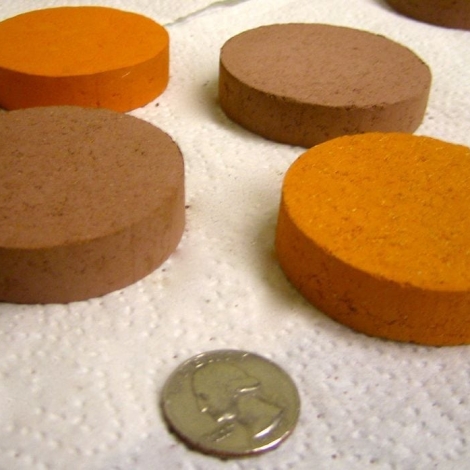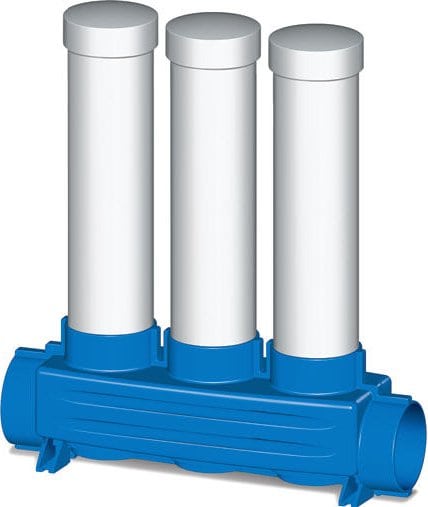
Drop one of these Madi Drops into a bucket of river or well water and it can purify it with silver nanoparticles. Photo by Rachel Schmidt
Simply drop a Madi Drop ceramic tablet into a bucket of dirty water to disinfect before drinking. That’s how easy it is to use. It works by releasing silver nanoparticles into water at a controlled rate, killing the microscopic creatures that cause disease.
“The MadiDrop is working just as well, if not better, than what we see in the literature with ceramic filter performance,” Beeta Ehdaie, a doctoral candidate in civil and environmental engineering at the US University of Virginia, who is leading the development of Madi Drop, told E4C.
Madi Drop doesn’t remove sediment, chemicals or other contaminants, but it may destroy most or all of the disease-causing microbes in drinking water. And new not-yet published data appear to support the claim.
Its makers plan to manufacture the drops at rural South African factories operated by the ceramic filter company Pure Madi. The drops could cost the equivalent of US $5, depending on the region.

Pure Madi manufactures these ceramic filters to treat water in rural South African communities. Photo by Rachel Schmidt
The making of Madi Drop
Ehdaie and her team developed Madi Drop during research at Pure Madi. “Madi,” by the way, means “water” in the South African language Tshivenda. As its etymology suggests, Pure Madi operates in South Africa, manufacturing ceramic, ionic silver-coated filters. The company got its start at the University of Virginia, also.
The filters and the new Madi Drop have much in common. The filters are the “flower pot” variety in the tradition of those made by Potters for Peace. To make them porous, sawdust is mixed into the clay. It burns out in the kiln leaving space for water to drip through. In the same way, the ceramic tablets have pores that contain a proprietary formulation of silver nanoparticles.
The idea for the drops, in fact, arose during research into better ways to manufacture the filters and the silver nanoparticles painted onto them.
“In the lab, we experimented with different methods of applying silver to the ceramic. We found a novel way that would be cheaper and requires fewer steps. In the process we had a eureka moment where we realized that if we make it into the shape of a tablet or a disk the silver can release at a controlled rate and that would serve as a water purifier,” Ehdaie says.
How well do Madi Drops work?
The performance data are not-yet published findings from field studies in rural South African communities. The researchers don’t want to give details until after publication, but Ehdaie has told us that the drops have disinfectant rates comparable to those of the filters.
One study of filters in 62 Guatemalan households in 2011 found that they reduced E. coli by 92 percent on average over a period of one to two years. They reduced the total number of coliforms by 87 percent on average. E. coli and other coliforms are bacteria that thrive in water. They are found in feces and soils and serve as an indicator for the creatures that could infect a source of water. In testing water quality, the idea is that if there are high numbers of coliforms, then the water is probably contaminated with other microbes, too.
Madi Drops may reduce total coliforms by 93 percent, according to the unpublished data.
Are Madi Drops safe?
In tests, Madi Drops release .01 to .05 mg/L of silver into the water, not enough to exceed the limit set by the US EPA of 0.1mg/L. Tests were conducted using 10 liter vessels, which are a common size in the communities where the researchers work. Even if left in a bucket for days, Madi Drop slows the release of silver into the water.
“From our field study (nine months) we have not seen silver levels go above the drinking water limit as the silver release plateaus between 8-10 hours, keeping silver levels well below the standard. As fresh water is added, we believe it creates a concentration gradient again which then leads to the release of silver again,” Ehdaie says.
For more information, please see puremadi.org.
This article was updated on May 20, 2014.
Related resources
E4C Webinar | From technologies to lasting services in water, sanitation and hygiene technologies
Learn about two tools that evaluate the viability of WASH technologies.
Research brief: The link between heavy rain, diarrhea and water treatment
Rain following drought may flush diarrhea-causing pathogens into the water supply. Treatment and sanitation my help. But only if they’re used.
From the Solutions Library
Clay Water Filters

